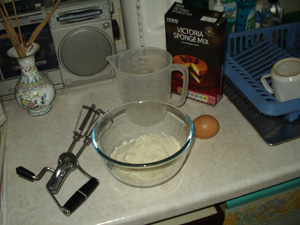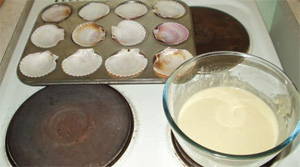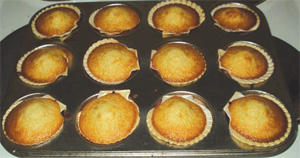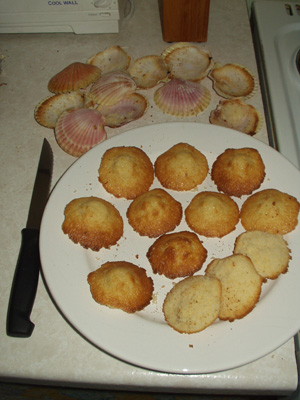|
The other day I settled down and made some ”Cockle cakes” or “Coquilles”. These little cakes were a traditional Easter specialty and there was a street cry to advertise them “Hot penny coquilles, smoking all hot”. We were told that fishermen’s wives originally used cockle shells to mould these small cakes before tin utensils were available. This is very unlikely in fact: the word “coquilles” actually refers to “A scallop-shaped dish or a scallop shell in which various foods are cooked and served”. We also know that in Southend-on-Sea these small cakes were actually baked in scallop shells. It is also most likely that they used the valves of Chlamys opercularis rather than the larger valves of Pecten maximus . Certainly the old baking tin that I have in my kitchen has a dozen scallop shaped cups of the size of Chlamys opercularis. As can be seen in the pictures I tried making these little cakes and not only was it very simple and easy, it was extremely successful. Cheats recipe: Take a packet of Sponge mix (I used a Tesco value 227g packet but I’m sure that the other supermarkets have identical packets) and follow the instructions on the back. Take one egg and 50ml of water in a mixing bowl. Mix together well, beat, then add a further 25ml of water and beat for another minute. Divide the mix up into 12 well greased scallop shells. Bake in an oven at around 200°C/350°F/Gas Mark 6 for approximately 15 minutes. Keep an eye on the cakes through the oven window and if they have risen and are light brown take them out immediately. One can, of course, use a baking tray with 12 scalloped cups instead but the shells are more fun. When the cakes are cool remove them from the shells. This might be a little tricky but like prizing a limpet off a rock one must take a thin, sharp kitchen knife, gently run it round under the cake and lever it out of the shell. Place a dollop of strawberry jam on one of the cockle cakes followed by some clotted cream. To make them look even more delicious sprinkle with icing sugar (or sweetener, if diabetic) over them. You can also use them as an addition to a dessert like a custard cream for instance. Below is a proper recipe one can use for the cake mix. For further information look under ‘British recipes Southendon- Sea Cockle cakes’ on the Internet. Recipe- Ingredients 1 oz.(28g) yeast; 2 oz.(56g) sugar or equivalent of sweetner); 2oz.(56g) butter; 1 lb.(454g) plain flour or leaving out the yeast use self raising flour instead; ½ pint (284ml) water and 1 egg. Method Cream the yeast and sugar (sweetner) with a little water. Rub the butter into the flour and work in the egg. Add the yeast mixture. If using self raising flour leave out the yeast mixture. Add a little of the remaining water to make a soft dough. Leave in a warm place for 30 minutes to prove/rise. Break up into scallop shell sized pieces. Place them into well greased scallop shells and bake. Carry on as above. In a future issue of ‘Mollusc World’ I will give another quite different use and recipe for ‘cockle cakes’. |
1. Ingredients
2. Cake mix and scallop shells
3. Straight out of the oven
4. The cakes taken out of the shells |
Coquilles in the kitchen
Issue
23
Page
9




